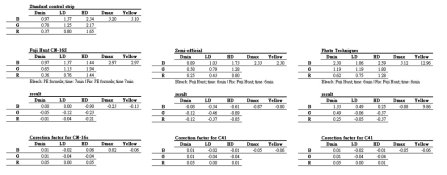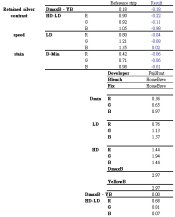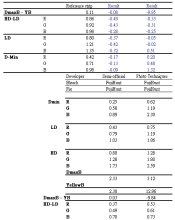ahock
Member
- Joined
- Feb 12, 2009
- Messages
- 37
- Format
- 35mm
I have collection some recipe of C41 from the web.
But the result is weird....
The film look like B&W film
Here is the scan image of the film

full size
note: there have two film scanned. The dark one is film(Fuji NPH 400) with home-made C41, the other one is film(Kodak Gold 200) developed with Fuji Hunt kits.
Here is the scan image :

IDK what is going wrong. I will list out my recipe and protocol. Please give me some hint, thanks!
Here is my recipe and protocol:
DEVELOPER {reference}
Water 800 ml
Potassium carbonate 38 g
Sodium sulfite 4.7 g
Potassium bromide 1.5 g
Kodak anti-cal (optional) 1 g
Hydroxylamine sulfate 3.9 g
CD4 5.9 g
Potassium iodide 1 mg (or 1ml 0.1% solution)
Acetic Acid to pH 10.00
Water to make 1 liter
Stop {reference: PE}
Acetic acid glacial 20ml/L
Sodium Sulfite 10 g/L
Water to 1000ml
Use between developer and bleach for 30 seconds 100F. This can prolong the life time of the bleach solution.
Bleach {(there was a url link here which no longer exists)}
Ammonium Bromide 50 g
Ammonium Sulfite 10 g
Diammonium EDTA 359g
Ferric chloride 162g
Disodium EDTA 10 g
Adjust pH to 6.5 with Acetic Acit 28% and Ammonium Hydroxide solution as needed.
Fixer {reference: PE}
Ammonium Thiosulfate 60% 200 ml
Ammonium Sulfite 10 g
Disodium EDTA 10 g
pH to 6.7 with either Ammonium Hydroxide or 28% acetic acid.
Water to 1 liter. Use for 7 minutes at 100 F.
pH range 6.5 - 6.8 for either solution at 20 degrees C (68F)
Wash after the bleach for 5 mins and after the fix for 8 mins.
Stabilizer {(there was a url link here which no longer exists)}
3ml Formaldehyde (35-37%) and 3ml L-clear (surfactant product of Chugai photo) to make 500ml
PROCESS TIMES (38 degree C)
Pre wet with water 5 minutes
Developer 3 minutes 25 seconds
Stop 30 seconds
Rinse 1 minutes x2
Bleach 7 minutes
Rinse 1 minutes x2
Fix 7 minutes
Rinse with Room temperature distill water for 6 minutes
Stabilizer 2 minutes (Room temperature)
I'm using Jobo 1520 tank. I pour in 500ml solution inside, and shaking continuously for the first minute. Shake method are upside down. upside down is one cycle, it is about 7 cycle for the first minute. Rest of the time are 30 seconds 1 cycle.
Here is the image:

I have check the solution temperature during the procedure.
For the developer temp, it is ~ 37.9 degree C.
For the bleach temp, it is ~ 37 degree C.
For the Fixer temp, it is ~ 37 degree C.
At last, I wonder could it be posible light leak problem?
Please advice, thanks!!!
But the result is weird....
The film look like B&W film

Here is the scan image of the film

full size
note: there have two film scanned. The dark one is film(Fuji NPH 400) with home-made C41, the other one is film(Kodak Gold 200) developed with Fuji Hunt kits.
Here is the scan image :

IDK what is going wrong. I will list out my recipe and protocol. Please give me some hint, thanks!
Here is my recipe and protocol:
DEVELOPER {reference}
Water 800 ml
Potassium carbonate 38 g
Sodium sulfite 4.7 g
Potassium bromide 1.5 g
Kodak anti-cal (optional) 1 g
Hydroxylamine sulfate 3.9 g
CD4 5.9 g
Potassium iodide 1 mg (or 1ml 0.1% solution)
Acetic Acid to pH 10.00
Water to make 1 liter
Stop {reference: PE}
Acetic acid glacial 20ml/L
Sodium Sulfite 10 g/L
Water to 1000ml
Use between developer and bleach for 30 seconds 100F. This can prolong the life time of the bleach solution.
Bleach {(there was a url link here which no longer exists)}
Ammonium Bromide 50 g
Ammonium Sulfite 10 g
Diammonium EDTA 359g
Ferric chloride 162g
Disodium EDTA 10 g
Adjust pH to 6.5 with Acetic Acit 28% and Ammonium Hydroxide solution as needed.
Fixer {reference: PE}
Ammonium Thiosulfate 60% 200 ml
Ammonium Sulfite 10 g
Disodium EDTA 10 g
pH to 6.7 with either Ammonium Hydroxide or 28% acetic acid.
Water to 1 liter. Use for 7 minutes at 100 F.
pH range 6.5 - 6.8 for either solution at 20 degrees C (68F)
Wash after the bleach for 5 mins and after the fix for 8 mins.
Stabilizer {(there was a url link here which no longer exists)}
3ml Formaldehyde (35-37%) and 3ml L-clear (surfactant product of Chugai photo) to make 500ml
PROCESS TIMES (38 degree C)
Pre wet with water 5 minutes
Developer 3 minutes 25 seconds
Stop 30 seconds
Rinse 1 minutes x2
Bleach 7 minutes
Rinse 1 minutes x2
Fix 7 minutes
Rinse with Room temperature distill water for 6 minutes
Stabilizer 2 minutes (Room temperature)
I'm using Jobo 1520 tank. I pour in 500ml solution inside, and shaking continuously for the first minute. Shake method are upside down. upside down is one cycle, it is about 7 cycle for the first minute. Rest of the time are 30 seconds 1 cycle.
Here is the image:

I have check the solution temperature during the procedure.
For the developer temp, it is ~ 37.9 degree C.
For the bleach temp, it is ~ 37 degree C.
For the Fixer temp, it is ~ 37 degree C.
At last, I wonder could it be posible light leak problem?
Please advice, thanks!!!
Last edited by a moderator:
















